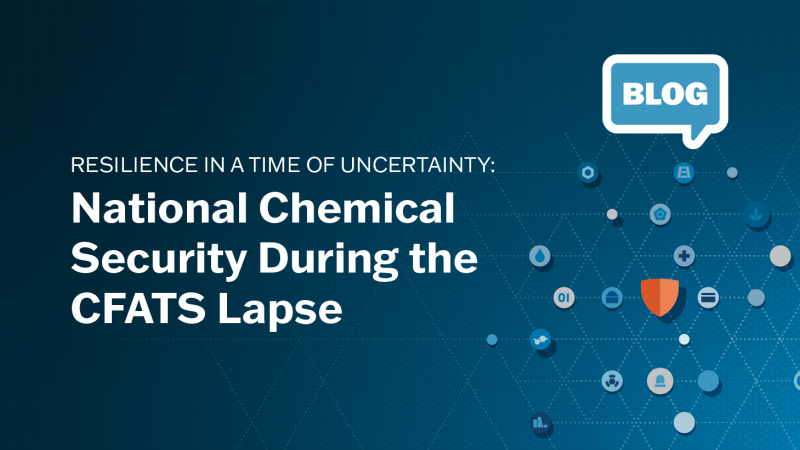Opinion | Can we Afford the Risk? Measuring the cost of the Expiration of the Chemical Facilities Anti-Terrorism Standards Program
It has been nearly three months since the American people lost an essential program guarding against the threat of terrorist exploitation of dangerous chemicals. For more than 15 years, the Chemical Facility Anti-Terrorism Standards (CFATS) program helped protect communities across the nation.
Through the CFATS program, the Cybersecurity and Infrastructure Security Agency (CISA) identified facilities with dangerous chemicals to reduce the risk that those chemicals could be weaponized by terrorists and other bad actors. The CFATS program was developed as a direct response to the terrorist attacks of 9/11, with the goal of preventing another attack of that scope. The over 300 chemicals monitored by the CFATS program, in the hands of those intent on harm, have the capability to release a toxic plume or create an explosion that in some cases could be as devastating as a nuclear blast.
On July 28, 2023, the CFATS authorization expired. The impact has been significant. CISA can no longer conduct CFATS inspections at high-risk sites, enforce the implementation of required physical and cyber security measures, or assess the risk to these facilities and the communities that surround them.
One of the most important provisions that came out of the CFATS legislation was the personnel surety vetting program. History has shown that hostile actors have attempted to use legitimate means to gain access to dangerous chemicals. To reduce this risk, CFATS mandated that anyone who might have direct access to a facility’s high-risk chemicals be vetted against the Terrorist Screening Database. CFATS ensured that CISA was vetting an average of 300 new names per day for persons with terrorist ties. As we approach the three-month mark for the program lapse, we have been unable to vet individuals gaining this level of access to dangerous chemicals. This means that since the end of July, we have not vetted over 25,000 individuals with access to dangerous chemicals who may be in position to use those chemicals in an attack on our communities.
The program’s effectiveness is not up for debate. The CFATS reauthorization bill proposed by the House passed on a bipartisan vote of 409-1 before stalling in the Senate. Industry leaders and Congress alike understand the benefits of the program, which has been reauthorized by broad bipartisan votes multiple times since its inception in 2007.
Over the past 15 years, CFATS has improved security at high-risk chemical facilities by an average of nearly sixty percent. To meet CISA’s security standards, high-risk facilities have implemented tens of thousands of new security measures such as cameras, alarms, fences and locks, training programs, cybersecurity, and community outreach.
High-risk chemical facilities are not evenly distributed across the country. Nor are they distributed uniformly across a state, or even within a single county. And far from what you might expect, they are not always isolated to the outskirts of well-populated areas. Of the over 3,200 facilities that CISA had determined to be at high risk of chemical terrorism, twenty-eight percent of them are located in the largest urban areas in the country. Over 7,000 schools, colleges, or universities stand within one mile of a high-risk facility. The same is true for over 300 hospitals. A terrorist incident at any one of these facilities could impact our most vulnerable citizens, along with their families, coworkers, and the surrounding community.
One of the CFATS program’s unsung virtues is the way that it has reduced risk exposure for our nation’s most underserved communities—communities that may be situated near a facility with dangerous chemicals yet lack the economic or political resources to advocate for adequate security measures. What the CFATS program has done is provide a measure of equality that comes from having a single national set of standards, rather than the patchwork of standards that existed on a state-by-state, or even county-by-county basis before the program was implemented. Now, those protections are gone, leaving each community to advocate for its own security with whatever economic resources and political levers are available.
Can we afford to return to the days before CFATS? Can we afford to ask communities to accept a higher degree of risk? Can we afford to give access to chemicals to those who want to cause our communities and our families harm? I don’t think we can afford to pay the price of inaction. The CFATS program is a rare example of a regime that is successful in implementing its regulations, directly strengthens our safety and security, and is supported by its regulated industry. When regulatory programs function properly, when they are non-controversial, it can be easy to underestimate the effects of their absence. We can’t afford to wait until an attack on a chemical facility shows us just how steep the price is of letting CFATS expire. I join my colleagues across CISA and the Department of Homeland Security in urging Congress to act swiftly to reauthorize this vital program.
Dr. David Mussington is the Executive Assistant Director for Infrastructure Security at the Cybersecurity and Infrastructure Security Agency.





